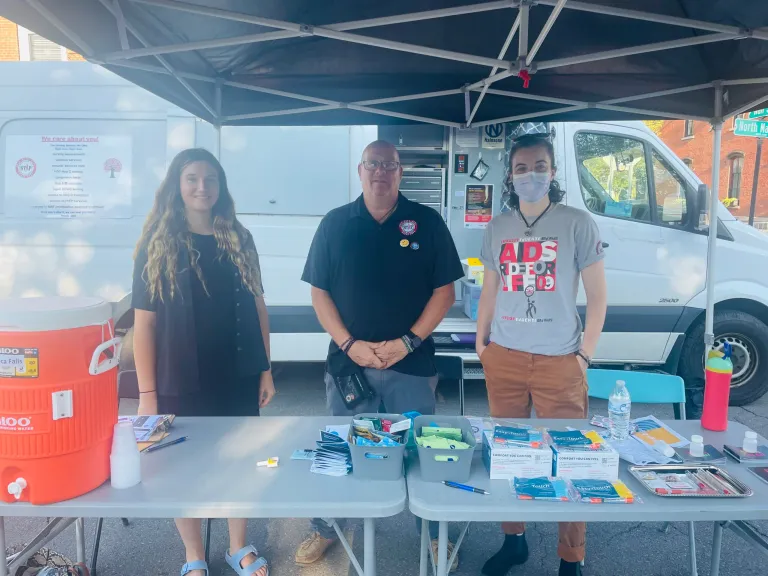CACTC's Healing Cortland Initiative Marks 3 Years of Working to Expand Narcan access!
In 2020, CACTC was contracted by Cortland County to administer the HEALing Communities Study in Cortland County--a county-wide effort to reduce opioid-overdose deaths as part of a national effort funded through the NIH. When the project kicked off in May 2020, it coincided with the beginning of the COVID-19 pandemic. Since traditional in person meetings were challenging, project staff instead met one-on-one with over 40 stakeholders to gather information and then determine how best to start this county-wide effort to reduce opioid overdose deaths. A reoccurring theme emerged: that, as a county, we were getting naloxone (Narcan) out there but not necessarily reaching those who needed it the most. Agencies were doing great work but there wasn't a county-wide effort to coordinate education and naloxone distribution. That is when the Naloxone Distribution Workgroup was created in July 2020.
Since then, local and regional Opioid Overdose Prevention Programs (OOPPs) and other stakeholders have been meeting on a regular basis to share what each program is doing and work in a coordinated manner to enhance our county-wide efforts to increase access to those at high risk of overdose and their social networks. This group has also done a lot of work to improve data collection to track and enhance outreach efforts.
What we know: Naloxone is a life-saving drug that can reverse the effects of an opioid overdose when administered in time. Targeted naloxone distribution programs seek to train and equip individuals who are most likely to encounter or witness an overdose—especially people who use drugs— with naloxone kits, which they can use in an emergency to save a life. The CDC lists targeted naloxone distributed as one of the evidence-based strategies for reducing overdose deaths.
What the data shows: OOPPs that serve Cortland County have substantially increased their naloxone distribution over the last few years, getting naloxone into the hands of more and more community members. This year is on track to be even higher than last, which would mark a new record.
What our community is doing: As part of the HEALing Communities Study project, Healing Cortland has been working with our local Opioid Overdose Prevention Programs (OOPPs) to move towards more targeted distribution of naloxone, to ensure we are filling gaps and are reaching those most likely to witness or encounter an overdose. Our strategies include:
Targeted outreach to unhoused individuals (at specific locations such as Cortland Free Library, Loaves & Fishes, the Warming Center, Salvation Army, encampments, and temporary housing)
Targeted rural outreach to fill an important gap (most distribution takes place in the City of Cortland)
Targeted outreach during off hours (after 9am-5pm or on weekends) when most agencies are closed
Working to pilot a naloxone leave behind program with a first responder program (Narcan is left with educational materials at the scene of an overdose)
Launching N-PODS–emergency use naloxone distribution boxes–especially targeting rural communities, in partnership with Healing Hearts Collaborative. Learn more here.
This work can be seen in action in the data below, showing the number of naloxone kits distributed that were targeting the key gaps and areas of need listed above:
Our reason for targeting our outreach is to get naloxone into the hands of individuals who it may not have been as easily accessible to previously, especially those at risk and their family and friends. Our hope is that we, as a community, can continue expanding distribution and continue preventing as many overdose deaths as possible.
There is data that is collected when Narcan is administered by a bystander or first responder at the scene of overdoses in the City of Cortland (reported by City PD). This data has shown that naloxone was used over 70 times, with 179 doses used in the last two years alone. These could have been fatal events if naloxone wasn’t present and used. Therefore, we are seeing the astounding impact naloxone distribution is making in the community. This is thanks to the hard work of our local OOPPs and the Healing Cortland Naloxone Distribution Workgroup.
We look forward to the continuation of the Naloxone Workgroup as local stakeholders work together to enhance coordination between agencies distributing naloxone and increasing the availability of this life-saving medication.
This Work in Action:
A huge THANK YOU to all of the dedicated partners and individuals who have helped support naloxone distribution efforts! We know countless lives have been saved by this important effort. We want to recognize all those past and present who have been part of this collective effort.





The history of Narcan distribution in Cortland County goes further back then HCS, visit the timeline here to learn more.


